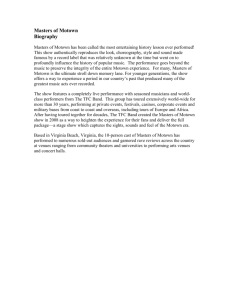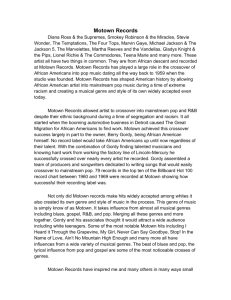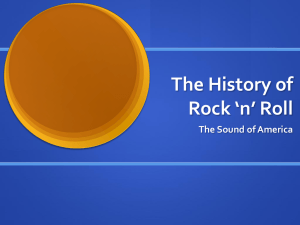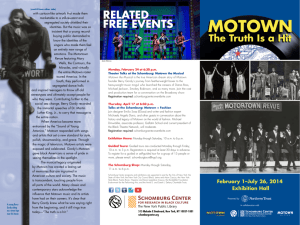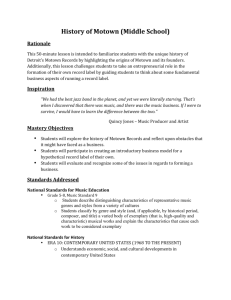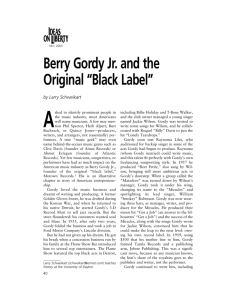Motown Museum 2001.rtf
advertisement
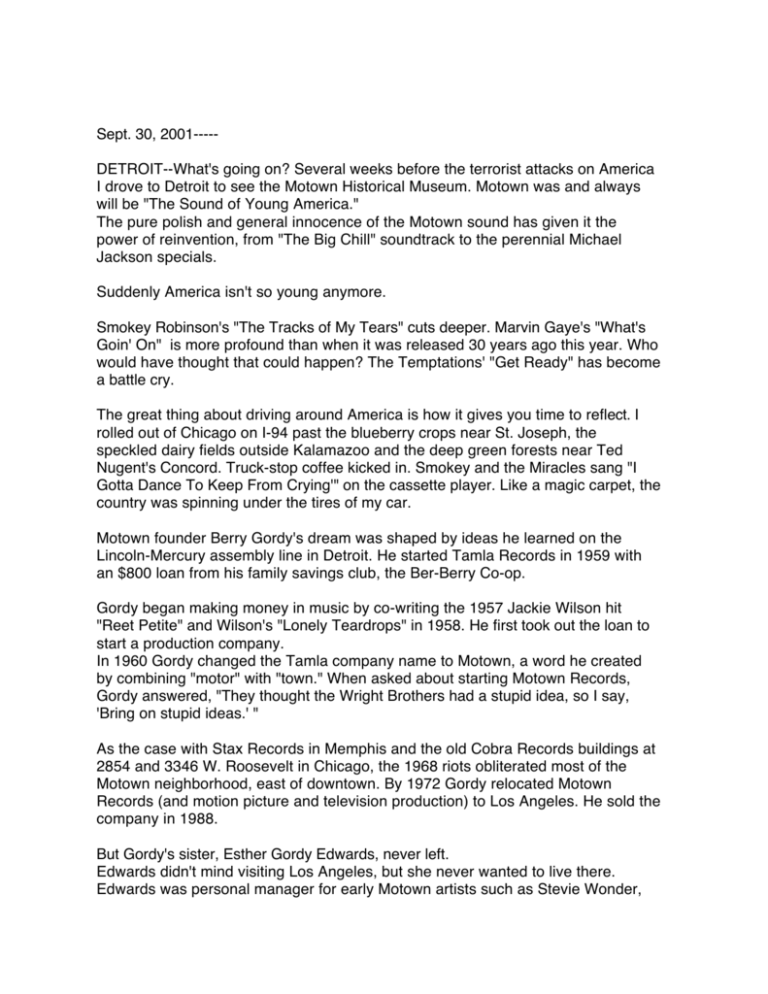
Sept. 30, 2001----DETROIT--What's going on? Several weeks before the terrorist attacks on America I drove to Detroit to see the Motown Historical Museum. Motown was and always will be "The Sound of Young America." The pure polish and general innocence of the Motown sound has given it the power of reinvention, from "The Big Chill" soundtrack to the perennial Michael Jackson specials. Suddenly America isn't so young anymore. Smokey Robinson's "The Tracks of My Tears" cuts deeper. Marvin Gaye's "What's Goin' On" is more profound than when it was released 30 years ago this year. Who would have thought that could happen? The Temptations' "Get Ready" has become a battle cry. The great thing about driving around America is how it gives you time to reflect. I rolled out of Chicago on I-94 past the blueberry crops near St. Joseph, the speckled dairy fields outside Kalamazoo and the deep green forests near Ted Nugent's Concord. Truck-stop coffee kicked in. Smokey and the Miracles sang "I Gotta Dance To Keep From Crying'" on the cassette player. Like a magic carpet, the country was spinning under the tires of my car. Motown founder Berry Gordy's dream was shaped by ideas he learned on the Lincoln-Mercury assembly line in Detroit. He started Tamla Records in 1959 with an $800 loan from his family savings club, the Ber-Berry Co-op. Gordy began making money in music by co-writing the 1957 Jackie Wilson hit "Reet Petite" and Wilson's "Lonely Teardrops" in 1958. He first took out the loan to start a production company. In 1960 Gordy changed the Tamla company name to Motown, a word he created by combining "motor" with "town." When asked about starting Motown Records, Gordy answered, "They thought the Wright Brothers had a stupid idea, so I say, 'Bring on stupid ideas.' " As the case with Stax Records in Memphis and the old Cobra Records buildings at 2854 and 3346 W. Roosevelt in Chicago, the 1968 riots obliterated most of the Motown neighborhood, east of downtown. By 1972 Gordy relocated Motown Records (and motion picture and television production) to Los Angeles. He sold the company in 1988. But Gordy's sister, Esther Gordy Edwards, never left. Edwards didn't mind visiting Los Angeles, but she never wanted to live there. Edwards was personal manager for early Motown artists such as Stevie Wonder, Marvin Gaye and the Supremes--when they were teenagers. Edwards is also founder of the Motown Museum, 2648 W. Grand Blvd. The museum was doing good business before the terrorist attacks, and now domestic tourism may pick up even more as people look for reasonable driving trips. The museum is just part of Detroit's renaissance. Detroit celebrates its 300th anniversary this year. The city was founded as a fur trading post on July 24, 1701, by Antonine de la Mothe Cadillac, who pegged it Ville D'etroit (City of the Strait). It is an invigorating road trip. Detroit is coming straight back atcha'. Stevie Wonder visited Hitsville U.S.A. in mid-July when he was in town for a 300th anniversary homecoming concert. Ain't nothing like the real thing. The Motown Museum is actually part of a district of seven Motown related homes that runs from 2648 W. Grand to 2457 Woodward. The museum is housed in the brick two-flat at 2648 W. Grand that Gordy purchased in 1959. Gordy lived upstairs. Early records were made in a converted photography studio attached to the house. Gordy's apartment has been restored to its 1959-60 era, right down to the original master bedroom set and living room couch. Gordy confidently erected a huge blue and white sign on the front of the house. The sign read, "Hitsville U.S.A." By 1971 Motown was the largest grossing black-owned company in the United States. The highlight of the museum is the Studio A, which features original Motown recording equipment. Only the carpeting on the steps which leads from a foyer into the studio has been replaced. The cigarette machine outside the studio still sells smokes for 35 cents. The intimacy of the space creates uncanny accessibility. A half-dozen microphones stand at attention on an old oak floor. A three-piece drum set is encompassed by windowed plywood wall that created an echo effect. You can stand in the middle of the studio and imagine you're Marvin Gaye and/or Tammi Terrell singing "You're All I Need To Get By." Early Motown sessions were recorded on two track recording console. Musicians played on one track, singers were on the other track. After the session, the two tracks were mixed down to one-track tape. The first Motown hits like the Miracles' "Shop Around" and the Contours' "Do You Love Me?" were recorded on two-track tapes. By 1965 the console was upgraded to eight-track capacity. Motown was the first recording company to use the eight-track soundboard to its full capacity. The most common response from visitors seeing the museum for the first time is how much great music could be created in such a small space. The entire museum (including the adjacent studio) encompasses just 2,000 square feet. "People have always come here from all over the world," Edwards said during a two-hour conversation in the original sales and marketing house next door to the museum. "A lot of Detroiters thought we moved. Well, the headquarters moved to Los Angeles, but people would still show up on the doorstep here, and they'd be so thrilled. They'd guess which building the studio was in. People from abroad still think it was a huge place. Once they get inside, they're floored. The last time Smokey Robinson was here, he broke down, cried and said, 'I don't know how we did this.' But I think I know why Motown was such a success. "Stevie Wonder was 10 years old when he walked through the door with one of the Miracles' little brothers. A number of artists came from one-parent families or maybe no-parent families. "But the house at 2648 W. Grand was open 24 hours a day." Visitors enter the museum through a long narrow hallway lined with original Motown album covers. They are guided upstairs to a mini museum featuring archival chestnuts like Smokey Robinson's songsheet to "My Girl," the Temptations' bright green sequined jackets and a Nov. 19, 1948 boxing poster promoting exfighter Berry Gordy on the undercard with Joe Louis at Olympia Stadium in Detroit. The archives are underscored with narratives such as this memory from Catherine Schaffner of the Marvelettes, who had hits like 1961's "Please Mr. Postman" and 1966's "Don't Mess With Bill." "We would work with (voice and choreography teacher) Cholly Atkins, sometimes for hours. You wouldn't feel like fooling with anybody else because by the time Cholly got through beating it into you, you were done, you know? But every artist had to attend these classes. So when we went out, we went out as a finished product." The polished sound connected with a young (white) America, more so than Stax in Memphis or Philly International in Philadelphia. Edwards said, "I don't know if we so much made music for whites as opposed to whites coming over to us. Most of the music came out of our own living, but Berry was always about love songs. Berry had a looseleaf school book of about 100 songs, and he told the artists how to shape their songs into boy-girl relationships. That was what the buying public wanted." A couple of Motown artists didn't buy into the regimentation. Edwards recalled, "Marvin Gaye was a favorite of mine. He was very religious. Sometimes he would be moody. People ask me which artists were easier for me. It's easier for me to answer which ones were most difficult. Marvin Gaye was one of those. Berry hired an agent to write good things about our artists. The agent told me to tell my brother not to spend my money on Marvin Gaye because he will do the opposite of what you tell him to do. "Marvin was a deep thinker. He was always concerned about social problems. I was his manager. He told me that when he was writing 'What's Going On' that God was writing the song, he had nothing to do with it." A portion of the upstairs museum suggests that Motown did not neglect political commentary. On display are 1970 Black Forum (a Motown label) spoken word releases by Langston Hughes, Stokley Carmichael and Dr. Martin Luther King's "Why I Oppose The War in Vietnam." And the Motown album "Guess Who's Coming Home? (Black Fighting Men Recorded in Vietnam )" is positioned next to R. Dean Taylor's "I Think, Therefore I Am" (with the 1970 hit "Indiana Wants Me" on Motown's Rare Earth records). The tour winds through Berry Gordy's upstairs apartment before heading downstairs to Studio A and out through an extensive gift shop. When you leave the museum, pay attention to the James H. Cole Home for Funerals, just east of the house at 2624 W. Grand. Ex-Temptation Paul Williams and other Motown figures have taken their final bow at Cole's. "Our sister Gwen Gordy requested that her services be at Cole's," Edwards said. "Gwen put out the first record Berry wrote alone Barrett Strong's 1960 hit "Money (That's What I Want)". That funeral home was there when Berry bought the house." "Money" is the record that jump-started Motown. It is the only song that has been recorded by the Beatles and the Rolling Stones. "Money" was first pressed on Tamla Records, but it was leased to Gwen Gordy's Anna label because she had more clout in a distribution deal with Chicago's Chess Records. The Motown Historical Museum is considering expanding its imprint to downtown, which has been revitalized by last year's opening of Comerica Park, the home of the Detroit Tigers. The Detroit Lions football team is also building a new $300 million Ford Field next to Comerica. Right now Detroit has to be the only city in the country with a three-story hockey bar and restaurant across the street from a baseball stadium. Motown wants to expand into the Motown Center building, also across the street from Comerica Park. Plans include a Motown-themed cafe, interactive exhibits and possibly condominiums on the building's top floors. Berry Gordy still owns the building, which was used for office space when the company outgrew its original headquarters. Edwards said Motown would not abandon its current museum. "I know Berry is very much behind that project," Edwards said. It is too easy to say that a spin through the Motown Historical Museum harkens back to a more innocent time. During its embryonic years Motown created music that emanated from a collective urban soul. By embracing this kind of unity, we can begin to pick up the pieces.

